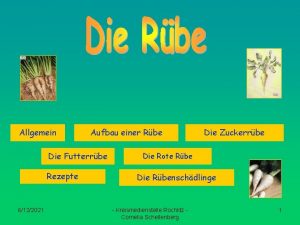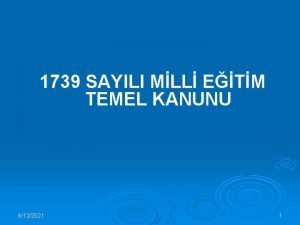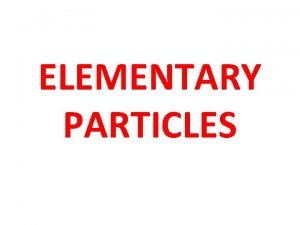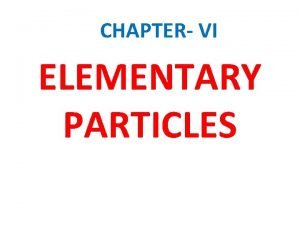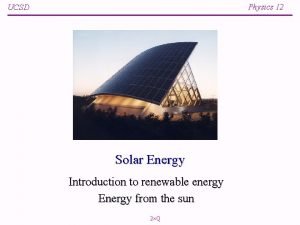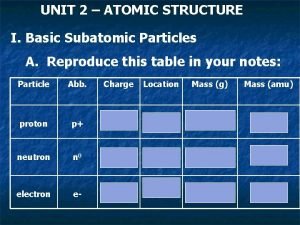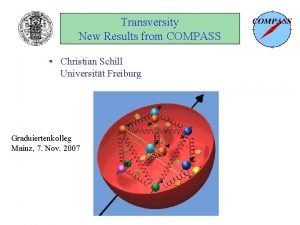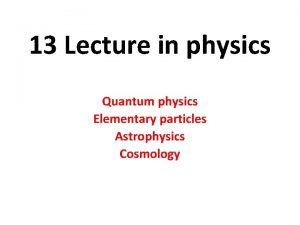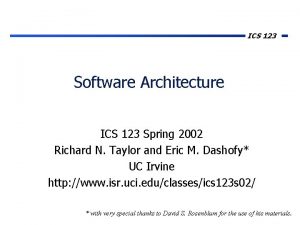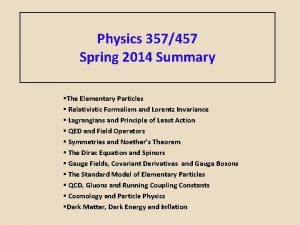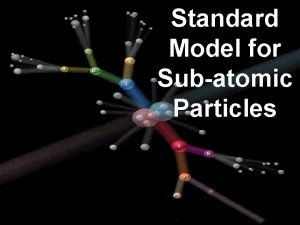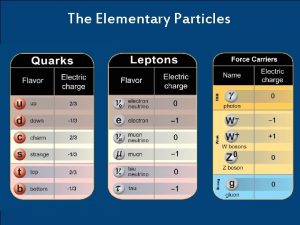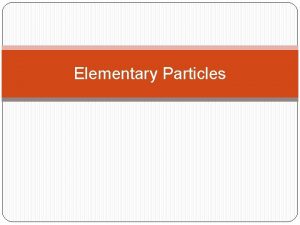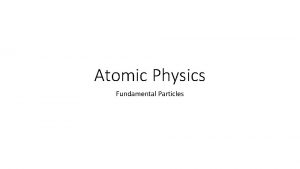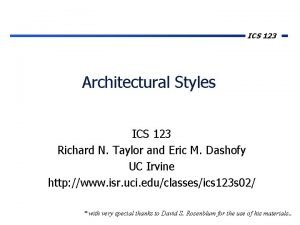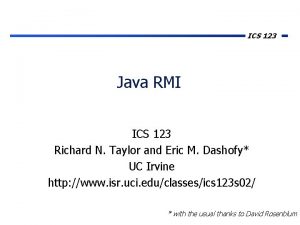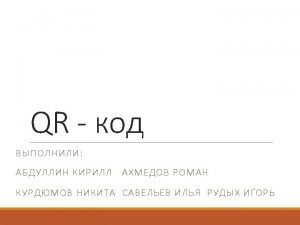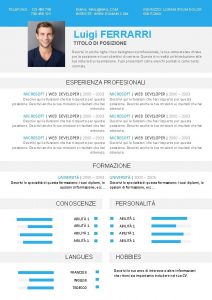Elementary particles Spring 2005 Physics 123 6122021 Lecture
























- Slides: 24

Elementary particles Spring 2005, Physics 123 6/12/2021 Lecture XXV 1

Concepts • • antimatter leptons quarks fundamental interactions 6/12/2021 Lecture XXV 2

Mass and energy • Mass and energy are interchangeable • Energy can be used to create mass (matter) • Mass can be destroyed and energy released 6/12/2021 Lecture XXV 3

Energy, mass and momentum • v c: • Mass is energy: • Energy –momentum - mass • Units for mass • v=c if and only if m 0=0 • Mg=0 • Units for momentum 6/12/2021 Lecture XXV 4

Particle acceleration • Electric field is used to accelerate the elementary particles and thus increase their energy • Energy is conserved, because particles receive their energy from the electric field • Energy of accelerated particles can be used to produce new particles (matters) 6/12/2021 Lecture XXV 5

Particle acceleration RF cavities 6/12/2021 Lecture XXV 6

Particle accelerators • Fermilab • 40 miles west of Chicago • Tevatron – at the moment world’s highest energy collider – 1 Te. V proton beam collides with 1 Te. V antiproton beam – 6. 28 km circumference • Top quark discovery - 1996 6/12/2021 Lecture XXV 7

Large Hadron Collider (LHC) • Next collider – LHC - is built in Europe, operational 2008 • 27 km; • 14 Tev - LHC will discover Higgs if it exists. • Two high PT experiments _CMS and Atlas 6/12/2021 Lecture XXV 8

Magnetic fields are used to separate positive from negative And measure particle velocity “Mustache” = matter – antimatter pairs Bubble chamber picture 6/12/2021 Lecture XXV 9

Detecting particles • Tracking charged particle in magnetic field - p • Calorimeter – collect all energy, energy loss light • The only particle that can survive calorimeter material – muon • Calorimeter is followed by another set of tracking devices – muon chambers 6/12/2021 Lecture XXV 10

Tracking: connecting the dots 40 cm 6/12/2021 Lecture XXV 11

Nature’s scales 6/12/2021 Lecture XXV 12

Matter = fermions (s=1/2) Leptons e ne m nm t nt Charge -1 e 0 ØAll fermions interact gravitationally and weakly. ØAll charged particles interact electromagnetically. ØOnly quarks interact strongly Quarks u d c s t b Charge +2/3 e -1/3 e For each fermion there exists an antiparticle with opposite electric charge 6/12/2021 Lecture XXV 13

Periodic table of forces S=1 Interaction Field particle Electromagnetic Photon g Comment Holds electron in orbit Strong Gluon g Holds nucleus Weak Gravity W+, W-, Z 0 -bosons Graviton G (? ? ) Reactions in the Sun Holds planets in orbit S=2 4 fundamental forces – others combinations of these. 6/12/2021 Lecture XXV 14

Fundamental interactions and Feynman diagrams • Gauge bosons (photon, W, Z, gluon, graviton) mediate fundamental interactions • Example: photon – quantum of EM field – Electron knows about the presence of another electron through EM field. In quantum language – through exchange of photons: eeg 6/12/2021 e- e. Lecture XXV 15

Periodic table of matter and forces Matter: Forces Gravity • 1 st generation – enough to build the Universe • Why 3 generation? • Mass hierarchy? • Why top is so heavy? 6/12/2021 ®EM and weak unified – Why M(g)=0 M(W)=80 Ge. V, M(Z)=90 Ge. V? – Electro Weak Symmetry Breaking Lecture XXV g W, Z 16

Higgs boson – generator of mass • Theoretical hypothesis: – Space is saturated with bosonic field (Higgs, s=0) with nonzero vev; – W, Z bosons absorb a component of this field and gain mass, while photon does not and remains massless – fermions acquire mass through interaction with Higgs boson. • Analogy – popular person in a party (massive particle) attracts a lot of people (Higgs boson) thus effectively gaining mass. • To test the hypothesis – find Higgs 6/12/2021 Lecture XXV 17

Higher generations – heavier replicas of the first generation I. I. Rabi 6/12/2021 • Muon discovered in 1930’s • Mass =105 Me. V/c 2 • Was a big surprise – first hint of extra generations • Particles of higher generations decay into particles of lower generation Lecture XXV 18

Top production • Statistics up to now : • 600 pb-1 3 x 1013 collisions • 4200 top pairs produced 6/12/2021 Lecture XXV 19

Top ID in “lepton+jets” channel • • • 6/12/2021 Fingerprint of top pair production: 2 b-jets Lepton: electron or muon Neutrino (from energy imbalance) 2 q’s – transform to jets of particles Lecture XXV 20

Top event 6/12/2021 Lecture XXV 21

Hadrons = composite quark states • Meson = combination of quark and antiquark: • Spin s=0 • Spin s=1 6/12/2021 • Baryons = combination of 3 quarks • Spin s=1/2 • Spin s=3/2 Lecture XXV 22

Conservation laws • Electric charge • Energy and momentum • Number of leptons and baryons (antilepton = -1, antibaryon = -1) Energy mass 6/12/2021 Mass energy Lecture XXV 23

Decays • • • Z-boson e+e- 3. 36% m+m- 3. 36% t+t- 3. 36% uubar 10. 1% ccbar 10. 1% ddbar 16. 6% ssbar 16. 6% bbbar 16. 6% All neutrinos 20% 6/12/2021 Z Lecture XXV 24
 6122021
6122021 6122021
6122021 6122021
6122021 Basic particles
Basic particles Classification of elementary particles
Classification of elementary particles 01:640:244 lecture notes - lecture 15: plat, idah, farad
01:640:244 lecture notes - lecture 15: plat, idah, farad Kim ki duk spring summer fall winter
Kim ki duk spring summer fall winter Spring what months
Spring what months Physics 111 lecture notes
Physics 111 lecture notes Physics 101 lecture
Physics 101 lecture Phy101 lecture 1
Phy101 lecture 1 Physics 101 lecture notes pdf
Physics 101 lecture notes pdf Waves 2 physics notes
Waves 2 physics notes Atmospheric physics lecture notes
Atmospheric physics lecture notes Physics spring
Physics spring Why does it happen
Why does it happen University physics with modern physics fifteenth edition
University physics with modern physics fifteenth edition Ib physics ia example
Ib physics ia example Ppt123
Ppt123 Ppt - 123
Ppt - 123 Welcome 123
Welcome 123 Plasma particles
Plasma particles Atom and subatomic particles
Atom and subatomic particles Point like particles
Point like particles Mass of protons neutrons electrons
Mass of protons neutrons electrons
